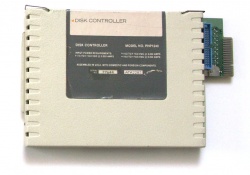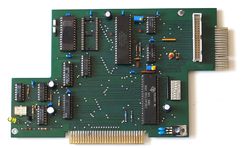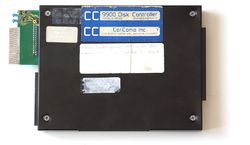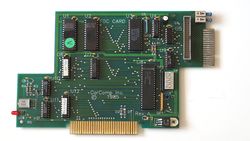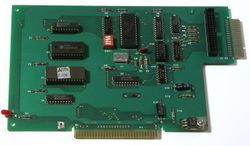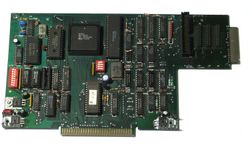Floppy Disk and Hard Disk Controller Cards
Texas Instruments designed the peripheral expansion system to utilize industry hardware, so it was merely necessary to provide a disk controller card while the disk drive could be selected from a broad selection of third-party drives.
The disk controller was arguably the first expansion card of every user, since it allowed to switch from cassette file handling to the much more comfortable disk system. Moreover, TI BASIC and Extended BASIC are well prepared for disk usage, so this was a wise investment.
Some cartridges like Editor/Assembler not only required a memory expansion but also a disk drive since the Editor and the Assembler were only available on disk,
Single-Density Floppy Disk Controller Card
The original floppy disk controller from TI allows to attach up to three double-sided floppy disk drives.
The controller card is based on the FD1771 Floppy Disk Controller chip, the first chip from the WD17xx family of Western Digital. This chip is capable of controlling 40-track drives with FM recording (single density), single- or double-sided, so we get 90 KiB storage space on SSSD (single-sided, single density) and 180 KiB on DSSD disks.
Later third-party modifications allow use of 80-track disk drives, which increase total possible storage to 360K per disk.
Double-Density Floppy Disk Controller Card
The TI Double-Density Floppy Disk Controller Card was released as a build-it-yourself kit to the members of the engineering department at Dallas (and possibly at other locations). It was never sold commercially. The card was designed to use a 765 floppy controller chip. Almost all known examples exhibit stability problems due to overheating of the voltage regulator chip unless a high-quality heat sink is installed (this was not included in the original design or the parts kit). Between 10 and 30 examples of this card are known to exist within the TI community.
This card allowed several different formatting options using the Disk Manager 3 cartridge. It had two Single-Density and two Double-Density formatting modes.
It would format in Single-Sided, Single-Density (SSSD) by dividing one side of the disk into 40 tracks of 9 sectors each, for a total of 90K per disk. This system could be extended to be used to format Double-Sided, Single-Density (DSSD) disks. The disks would then have 40 tracks of 9 sectors each on each side of the disk, for a total of 180K per disk. Data was written to the disk using the FM method to separate data and timing signals, placing the timing data between the data sectors.
It would also format in Single-Sided, Double-Density (SSDD) mode. This followed the Texas Instruments specifications for Double-Density, a standard that was ignored for all third-party controllers except the ones from Myarc. The disk was again divided into 40 tracks, but now it had 16 sectors per track, for a total of 160K. Once again, the controller could extend this scheme to use it with a Double-Sided, Double-Density (DSDD) disk. Each side of the disk has 40 tracks of 16 sectors for a total of 320K. Disks formatted in either of the 16-sector double-density formats can not be read by CorComp, Atronic, or BwG double-density disk controller cards, but can be read by the Myarc controllers or when using any manufacturer's DSDD controller with a Geneve 9640.
Atronic Double-Density Floppy Disk Controller
This card came with a disk manager program on disk, which it would auto-load during the boot process if it was in DSK1. The disk manager was in Assembly and required a 32K Memory Expansion to be present to load. Many programs testing for Floppy Disk Controllers will misidentify this one as a CorComp product. The two cards use the same Disk Controller chip. Between 50 and 100 examples of this card were sold.
CorComp Double-Density Floppy Disk Controller
This card was one of the most popular third-party expansion cards for the TI-99/4A. Several different revisions are known. The earliest examples have a WD2793 disk controller chip.
Later, they were built around the WD1773 disk controller chip. The earliest cards came in a gray aluminum shell, which soon gave way to the most common version with a black aluminum shell. The later versions eliminated the shell completely as a cost-cutting measure.
Myarc Personality Card
This was the first hard disk controller for the TI-99/4A. The Personality Card allowed the computer to interface with external SASI hard disks, of between 5 and 15 Megabytes. Most systems were sold with 10 Megabyte disk drives. Very few examples of this card were sold, as the list price for one of the 10 Megabyte systems was in the vicinity of $2,500. It was possible to set the card at different CRU addresses and put multiple examples into a single PEB. This was rarely done.
Myarc Double-Density Controller Card
Myarc's Double-Density Controller Card (DDCC) features a WD1770 controller chip. In contrast to the lowered package number compared to the WD1771, this chip contains an internal data separator and write precompensator, and allows for using double density (see also the descriptions on WD1771 in Wikipedia). Unlike the much more complex HFDC, the DDCC is a comparably robust disk controller which works flawlessly with 5,25" and 3,5" drives with up to 80 tracks and MFM recording. Thus, this controller handles disks with up to 720 KiB. The most frequently used format was DSDD40.
Myarc Hard and Floppy Disk Controller
The Myarc HFDC was one of the most sophisticated controllers built for the TI computer family. It allows to control up to four floppy disk drives and up to three MFM hard disk drives; moreover, the controller was prepared to control one tape drive. Note that it was not possible to write to the third hard disk drive due to a missing control line on the connector, making that drive read-only.
Some versions of the HFDC shipped as "HDCC-1 Winchester Card / Hard Disk Controller Card with Floppy Disk Option". The picture shows the PCB of such a controller.
Controller chip
The controller makes use of the HDC9234 controller from the SMC92x4 controller family.
Supported drives
The HFDC can support up to (3) MFM hard drives with capacities up to 134mb each, type ST506. The card can also support up to (4) floppy drives that are either 40 or 80 tracks and either single or double density. This includes both 5.25" drives and 3.5" drives.
Hard Drives
The HFDC can use any MFM drive that is ST506/412 compatible and it can be up to 134mb in size. You CANNOT use RLL drives.
ST504 or ST506 (ST416 or ST412)
The ST504 and ST506 are interfaces created by Seagate and used as standards for MFM drives and controllers. The HFDC was designed to work with ST504 interface but works with ST506 drives with less than 8 heads. Here is some background information for both of the interfaces.
ST504 • Equivalent to the ST416 interface. • Earliest interface for IBM XT. • Supported 5/10 MB drives. • Drive control on the interface card. • Very slow response. • Very spastic. • Mostly used MFM data encoding. • Separate cables for control and data.
ST506 • Equivalent to the ST412 interface.. • Standard interface used on XT and AT drives and controllers. • Originally developed by Seagate Technologies to support their ST506 (5 MB) and ST412 (10 MB) drives. • The entire controller mechanism is located on a controller card and communications between the drive and controller flow over 2 ribbon cables - one for drive control and one for data.
Larger Hard Drives
Micropendium December 1991 issue page 36 carried an article on modifying the card to use larger hard drives, affecting the cards compatibility with ST504 drives but not ST506 drives.
Floppy Drives
The HFDC will control 720k, 3.5" floppy drives. There is a 36 sector per track option for the HFDC that if installed will allow the card to control 1.44mb 3.5" drives. If you install another FDC along with the Myarc you can control up to (8) floppy drives. The additional FDC would control drives 1-4, the HFDC would control drives 5-8.
The HFDC was known to show some reliability issues with floppy disks, so in some cases people used the controller just to access the hard drives, next to another floppy disk controller like the Myarc DDCC.
Use of 1.44MB (high density) disks is possible and reliable, under three conditions:
- The data separator is the 9216B version, not the commonly installed 9216 version. Some 9216s are capable of the faster transfer rate but are not rated for it. The FDC9216 chip is overclocked to 8mhz and will support DSDD drives.
- The memory must be upgraded from 8k to 32k (The standard HFDC comes with 8K of memory, the 6264 chip. You can upgrade this chip to the full 32K by replacing it with a 62256)
- The card must be used with a Geneve.
Tape Drives
While the manual states that there is a capability of handling tape drives, there is no known application of a tape drive for this controller.
Quirks and Upgrades
AM26L32PC chip is buggy and can cause 'quirky' system problems. If you have one of these chips it is suggested to replace it with a AM26LS32AC.
The part of the HFDC that sticks out the back of the PEB has control lines that run from the AM26LS32x chip to the hard drive connectors. This can be scraped and cause shorts- a bit of insulation tape will keep problems down.
There is a a 45 second delay on the HFDC while it waits for the HD to activate its ready line.
Nouspikel IDE Interface
see article IDE Project Card
Nouspikel Smart Media/USB Interface
Refer to article Smart Media/USB Interface
SNUG ASCSI Card
See article SNUG Advanced SCSI Card
SNUG BwG DSDD Disk Controller Card
Refer to article SNUG BwG DSDD Disk Controller Card
Western Horizon Technologies (WHTech) SCSI Controller
TODO
Percom Data TX99 sidecar DSSD
TODO
